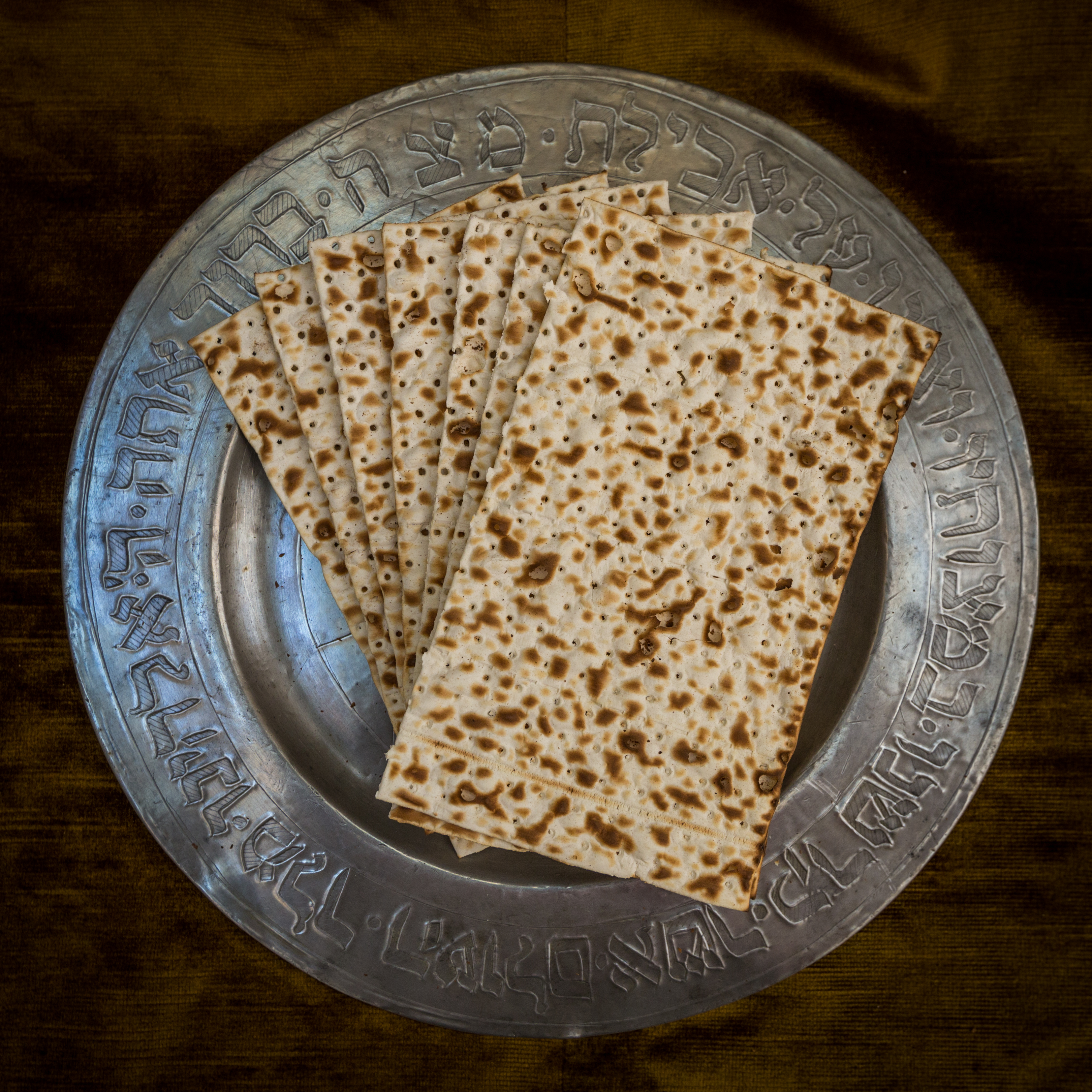|
Mazzah
Matzah or matzo ( he, מַצָּה, translit=maṣṣā'','' pl. matzot or Ashkenazi Hebrew, Ashk. matzos) is an Unleavened bread, unleavened flatbread that is part of Jewish cuisine and forms an integral element of the Passover festival, during which ''chametz'' (leaven and five grains that, per Jewish Law, are self-leavening) is forbidden. As the Torah recounts, God commanded the Israelites (modernly, Jews and Samaritans) to eat only unleavened bread during the seven day Passover festival. Matzah can be either soft like a pita loaf or crispy. Only the crispy variety is produced commercially because soft matzah has a very short shelf life. Matzah meal is crispy matzah that has been ground to a flour-like consistency. Matzah meal is used to make matzah balls, the principal ingredient of matzo ball soup, matzah ball soup. Sephardic Jews typically cook with matzah itself rather than matzah meal. Matzah that is kosher for Passover is limited in Ashkenazi tradition to plain matz ... [...More Info...] [...Related Items...] OR: [Wikipedia] [Google] [Baidu] |
Pita
Pita ( or ) or pitta (British English), is a family of yeast-leavened round flatbreads baked from wheat flour, common in the Mediterranean, Middle East, and neighboring areas. It includes the widely known version with an interior pocket, also known as Arabic bread ( ar, خبز عربي; ''khubz ʿarabī''). In the United Kingdom, Greek bread is used for pocket versions such as the Greek pita, and are used for barbecues to a souvlaki wrap. The Western name ''pita'' may sometimes be used to refer to various other types of flatbreads that have different names in their local languages, such as numerous styles of Arab ''khubz'' (bread). History Pita has roots in the prehistoric flatbreads of the Middle East. There is evidence from about 14,500 years ago, during the Stone Age, that the Natufian people in what is now Jordan made a kind of flatbread from wild cereal grains. Ancient wheat and barley were among the earliest domesticated crops in the Neolithic period of about 10,000 ye ... [...More Info...] [...Related Items...] OR: [Wikipedia] [Google] [Baidu] |
Egypt
Egypt ( ar, مصر , ), officially the Arab Republic of Egypt, is a transcontinental country spanning the northeast corner of Africa and southwest corner of Asia via a land bridge formed by the Sinai Peninsula. It is bordered by the Mediterranean Sea to the north, the Gaza Strip of Palestine and Israel to the northeast, the Red Sea to the east, Sudan to the south, and Libya to the west. The Gulf of Aqaba in the northeast separates Egypt from Jordan and Saudi Arabia. Cairo is the capital and largest city of Egypt, while Alexandria, the second-largest city, is an important industrial and tourist hub at the Mediterranean coast. At approximately 100 million inhabitants, Egypt is the 14th-most populated country in the world. Egypt has one of the longest histories of any country, tracing its heritage along the Nile Delta back to the 6th–4th millennia BCE. Considered a cradle of civilisation, Ancient Egypt saw some of the earliest developments of writing, agriculture, ur ... [...More Info...] [...Related Items...] OR: [Wikipedia] [Google] [Baidu] |
The Exodus
The Exodus (Hebrew language, Hebrew: יציאת מצרים, ''Yeẓi’at Miẓrayim'': ) is the founding myth of the Israelites whose narrative is spread over four books of the Torah (or Pentateuch, corresponding to the first five books of the Bible), namely Book of Exodus, Exodus, Book of Leviticus, Leviticus, Book of Numbers, Numbers, and Book of Deuteronomy, Deuteronomy. The majority of modern scholars date the composition of the Torah to the Yehud (Persian province), Middle Persian Period (5th century BCE). Some of the traditions contributing to this narrative are older, since allusions to the story are made by 8th-century BCE prophets such as Amos (prophet), Amos and Hosea. The consensus of modern scholars is that the Bible does not give an accurate account of the origins of the Israelites, who appear instead to have formed as an entity in the central highlands of Canaan in the late second millennium BCE from the indigenous Canaanites, Canaanite culture. Most modern scholar ... [...More Info...] [...Related Items...] OR: [Wikipedia] [Google] [Baidu] |
Fruit Juice
Juice is a drink made from the extraction or pressing of the natural liquid contained in fruit and vegetables. It can also refer to liquids that are flavored with concentrate or other biological food sources, such as meat or seafood, such as clam juice. Juice is commonly consumed as a beverage or used as an ingredient or flavoring in foods or other beverages, as for smoothies. Juice emerged as a popular beverage choice after the development of pasteurization methods enabled its preservation without using fermentation (which is used in wine production). The largest fruit juice consumers are New Zealand (nearly a cup, or 8 ounces, each day) and Colombia (more than three quarters of a cup each day). Fruit juice consumption on average increases with a country's income level. Etymology The word "juice" comes from Old French in about 1300; it developed from the Old French words "''jus, juis, jouis''", which mean "liquid obtained by boiling herbs". The "Old French ''jus'' "juice, s ... [...More Info...] [...Related Items...] OR: [Wikipedia] [Google] [Baidu] |
Sephardic
Sephardic (or Sephardi) Jews (, ; lad, Djudíos Sefardíes), also ''Sepharadim'' , Modern Hebrew: ''Sfaradim'', Tiberian Hebrew, Tiberian: Səp̄āraddîm, also , ''Ye'hude Sepharad'', lit. "The Jews of Spain", es, Judíos sefardíes (or ), pt, Judeus sefarditas or Hispanic Jews, are a Jewish diaspora population associated with the Iberian Peninsula. The term, which is derived from the Hebrew ''Sepharad'' (), can also refer to the Mizrahi Jews of Western Asia and North Africa, who were also influenced by Sephardic law and customs. Many Iberian Jewish exiles also later sought refuge in Mizrahi Jewish communities, resulting in integration with those communities. The Jewish communities of the Iberian Peninsula prospered for centuries under the Muslim reign of Al-Andalus following the Umayyad conquest of Hispania, but their fortunes began to decline with the Christians, Christian ''Reconquista'' campaign to retake Spain. In 1492, the Alhambra Decree by the Catholic Monarchs of ... [...More Info...] [...Related Items...] OR: [Wikipedia] [Google] [Baidu] |
Barley
Barley (''Hordeum vulgare''), a member of the grass family, is a major cereal grain grown in temperate climates globally. It was one of the first cultivated grains, particularly in Eurasia as early as 10,000 years ago. Globally 70% of barley production is used as animal fodder, while 30% as a source of fermentable material for beer and certain distilled beverages, and as a component of various foods. It is used in soups and stews, and in barley bread of various cultures. Barley grains are commonly made into malt in a traditional and ancient method of preparation. In 2017, barley was ranked fourth among grains in quantity produced () behind maize, rice and wheat. Etymology The Old English word for barley was ', which traces back to Proto-Indo-European and is cognate to the Latin word ' "flour" (''see corresponding entries''). The direct ancestor of modern English ''barley'' in Old English was the derived adjective ''bærlic'', meaning "of barley". The first citation of t ... [...More Info...] [...Related Items...] OR: [Wikipedia] [Google] [Baidu] |
Spelt
Spelt (''Triticum spelta''), also known as dinkel wheat or hulled wheat, is a species of wheat that has been cultivated since approximately 5000 BC. Spelt was an important staple food in parts of Europe from the Bronze Age to medieval times. Now it survives as a relict crop in Central Europe and northern Spain, and it has found a new market as a health food. Spelt is sometimes considered a subspecies of the closely related species common wheat (''Triticum aestivum''), in which case its botanical name is considered to be ''Triticum aestivum'' subsp. ''spelta''. Like common wheat, it is a hexaploid wheat, which means it has six sets of chromosomes. Evolution Spelt has a complex history. It is a wheat species known from genetic evidence to have originated as a naturally occurring hybrid of a domesticated tetraploid wheat such as emmer wheat and the wild goat-grass '' Aegilops tauschii''. Genetic evidence shows that spelt wheat can also arise as the result of the hybridisation ... [...More Info...] [...Related Items...] OR: [Wikipedia] [Google] [Baidu] |
Wheat
Wheat is a grass widely cultivated for its seed, a cereal grain that is a worldwide staple food. The many species of wheat together make up the genus ''Triticum'' ; the most widely grown is common wheat (''T. aestivum''). The archaeological record suggests that wheat was first cultivated in the regions of the Fertile Crescent around 9600 BCE. Botanically, the wheat kernel is a type of fruit called a caryopsis. Wheat is grown on more land area than any other food crop (, 2014). World trade in wheat is greater than for all other crops combined. In 2020, world production of wheat was , making it the second most-produced cereal after maize. Since 1960, world production of wheat and other grain crops has tripled and is expected to grow further through the middle of the 21st century. Global demand for wheat is increasing due to the unique viscoelastic and adhesive properties of gluten proteins, which facilitate the production of processed foods, whose consumption is inc ... [...More Info...] [...Related Items...] OR: [Wikipedia] [Google] [Baidu] |
Five Species
In Judaism, the five species of grain ( he, חמשת מיני דגן, hameshet minei dagan) refer to five varieties of grain which have special status for a number of rituals. These species are commonly considered to be wheat, barley, oats, rye and spelt. However, some of these identifications are disputed. Identity The five species, with their Mishnaic Hebrew names, are as follows: * ( ) – wheat * ( ) – spelt, but modernly taken to refer to emmer wheat * ( ) – barley * ( ) – oats or two-rowed barley. The name literally means "fox ear". Rashi holds this to be oats, and Maimonides holds it to be a type of "wild barley," while Rabbi Nathan ben Abraham called it by its Arabic name (Fox's spike).Zohar Amar and El'ad Kapah, ''The Yemenite Commentary of Rabbi Nathan, President of the Academy, on the Identification of Flora in the Mishnah'', pub. in: ''Mittuv Yosef – Yosef Tobi Jubilee Volume'', The Jews of Yemen: History and Culture (vo ... [...More Info...] [...Related Items...] OR: [Wikipedia] [Google] [Baidu] |
Refined Grain
Refined grains have been significantly modified from their natural composition, in contrast to whole grains. The modification process generally involves the mechanical removal of bran and germ, either through grinding or selective sifting. Overview A refined grain is defined as having undergone a process that removes the bran, germ and husk of the grain and leaves the endosperm, or starchy interior. Examples of refined grains include white bread, white flour, corn grits and white rice. Refined grains are milled which gives a finer texture and improved shelf life. Because the outer parts of the grain are removed and used for animal feed and non-food use, refined grains have been described as less sustainable than whole grains. After refinement of grains became prevalent in the early 20th-century, nutritional deficiencies (iron, thiamin, riboflavin and niacin) became more common in the United States.Sizer, Frances; Whitney, Ellie. (2013). ''Nutrition: Concepts and Controversies''. ... [...More Info...] [...Related Items...] OR: [Wikipedia] [Google] [Baidu] |
Whole Grain
A whole grain is a grain of any cereal and pseudocereal that contains the endosperm, germ, and bran, in contrast to refined grains, which retain only the endosperm. As part of a general healthy diet, consumption of whole grains is associated with lower risk of several diseases. Whole grains are a source of carbohydrates, multiple nutrients and dietary fiber. Varieties Whole grain sources include: Cereals * Wheat ( spelt, emmer, farro, einkorn, Kamut, durum) * Rice (black, brown, red, and other colored rice varieties) * Barley (hulled and dehulled but not pearl) * Maize or Corn * Rye * Oats (including hull-less or naked oats) Minor cereals * Millets * Sorghum * Teff * Triticale * Canary grass * Job's tears * Fonio, Digitaria iburua, black fonio, Asian millet * Wild rice Pseudocereals * Amaranth * Buckwheat, Fagopyrum tataricum, Tartary buckwheat * Quinoa Health effects Nutrition Whole grains are a source of multiple nutrients and dietary fiber, recommended for ... [...More Info...] [...Related Items...] OR: [Wikipedia] [Google] [Baidu] |








